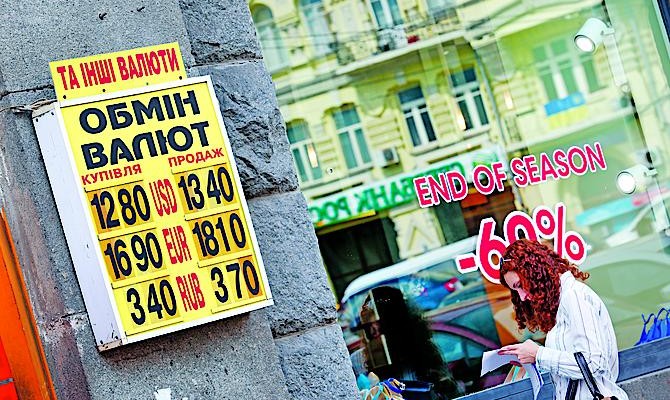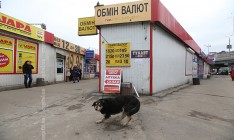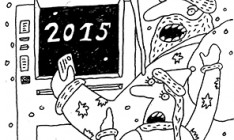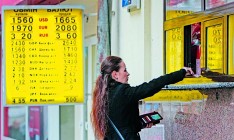Finance
currencyDollar auctions gave a jump-start to further devaluation of the hryvnia

Yesterday, the National Bank of Ukraine held its first hard currency auction in a new format the objective of which was to establish a new equilibrium of the exchange rate of the Ukrainian currency. Based on its results, the rate of the hryvnia fell from UAH 12.95/USD fixed since October 10 to UAH 13.50/USD or 4.2%. Meanwhile, on the inter-bank exchange market the rate on closing fell to almost UAH 14/USD. Following the devaluation of the hryvnia on the non-cash market, the rate will accordingly fall on the cash market. Interestingly, banks believe the devaluation of the hryvnia during the first auctions held by the NBU is a temporary phenomenon and predict that its rate will not drastically fall.
Practice makes perfect
At the first hard currency auction of the new format the NBU decided to start with minimum sales volumes. On Wednesday it put up on auction hard currency in the amount of up to US $5 mn, though it earlier informed that the volume of daily auctions would be US $5-10 mn. 88 banks were allowed to participate in the trading for which the NBU sets short-term credit limits. Each of the banks was granted the right to submit bids to the tune of UAH 100,000-500,000. As the NBU informed, a total of 178 bids were submitted by 64 banks in the total amount of US $26.12 mn.
Banks were ready to buy hard currency at the rate of UAH 12.90-13.81/USD, but the NBU accepted bids in which the rate was no lower than UAH 13.41/USD. To sum it up, US $5 mn were divided among 19 banks. On their basis of 41 bids, the new weighted average rate on the next day was calculated at UAH 13.52/USD.
Open market
The weighted average rate on the auction is used as an indicative hard currency rate for the entire trading market. In particular, the calculated rate is set as the main rate for that day for the closing of deals on the inter-bank exchange. As such, on Wednesday the inter-bank exchange began operating only after the indicative rate was announced at 11:00 am. By 14:00 the average weighted rate on the inter-bank exchange was UAH 13.50/USD. This rate was figured into the official rate. But after that the rate continued to fall and the sale rate on auctions reached UAH 14/USD. When the inter-bank exchange closed the rate was UAH 13.60-13.99/USD, according to statistics of the Ukrdealing company. For comparison, by the closing of trading on the inter-bank exchange on Tuesday this range was UAH 12.96-13.46/USD.
Meanwhile, the volumes of trading on the inter-bank exchange, after the NBU de-facto annulled the upper ceiling of the hryvnia rate of UAH 12.95/USD and allowed the rate to be set based on auction bids, did not increase. Yesterday the volume of deals in U.S. dollars closed on the inter-bank exchange amounted to a mere US $178.3 mn and did not even reach the average monthly indicator.
The exchange rate calculated on the auction sets the rate at which banks sell and buy hard currency cash on the day following the auction. As written in the NBU document sent to banks on Tuesday, “authorized banks may use the indicative hard currency rate of the previous day with a 5% deviation as a yardstick when setting the buy-sell rate”. This means that today the buy-sell rate may fluctuate in the range of UAH 12.84-14.20/USD based on the indicative rate offered yesterday. On Monday Ukrainians could sell and buy hard currency in banks and exchange points for much cheaper – UAH 12.89-13.02/USD, according to NBU data.
Treading carefully into the future
Banking experts cannot say how long the drop in the value of the hryvnia will last. In the opinion of Chairman of the Board of Raifeissen Bank Aval Volodymyr Lavrenchuk, a stable corridor for the fluctuation of the exchange rate can be established in two-three months. But this is only on condition that the military conflict in the east of Ukraine does not escalate.
As Chairman of the Board of Credit Agricole Bank Yevheniya Chemeris presumes, at the moment it is difficult to predict the situation on the hard currency market as it remains unclear whether Ukraine will go to war in the Donbas region or not. If this does not happen, she says the fluctuation of the exchange rate and its possible decline will continue to the end of the year until Ukraine receives loans from the International Monetary Fund, the World Bank and other lenders. As a reminder, the third and fourth tranches of IMF loans to Ukraine are planned for the start of 2015.
In addition, activity on the exchange rate will depend on how quickly exporters will begin to sell their earnings. In September agrarians began selling their products, but many of them are holding back their reserves until December in expectation of a seasonal rise in prices. The rest of the exporters in the metallurgy and chemical industries are mostly situated in the ATO zone and are only beginning to restore operations.
At the end of October nine of 15 blast furnaces at steel mills in the Donbas region were operating. Restoration of the region’s chemical industry is being observed. Specifically, the Alchevsk Coke and Chemical Plant restored operation on September 29, the Khartsyzsk Pipe Plant – on October 13, and the Makiyivka subsidiary of the Yenakiyevo Metallurgy Plant – on October 21. “However, even if production at metallurgy and chemical plants and the export of their products is restored, whether Ukraine will see the earnings of these companies remains under question,” Chemeris pointed out. She added that whatever the case may be banks will not allow the hryvnia to fall deep as devaluation has a negative impact on their capital.
“The critical level of the exchange rate is specific for every bank. For example, for us at the moment this rate is UAH 14-14.20/USD,” says the COB of Credit Agricole. As a result, in her opinion, the rate will stabilize in the range of UAH 13-13.50/USD.






 of the agreement of syndication with Financial Times Limited are strictly prohibited. Use of materials which refers to France-Presse, Reuters, Interfax-Ukraine, Ukrainian News, UNIAN agencies is strictly prohibited. Materials marked
of the agreement of syndication with Financial Times Limited are strictly prohibited. Use of materials which refers to France-Presse, Reuters, Interfax-Ukraine, Ukrainian News, UNIAN agencies is strictly prohibited. Materials marked  are published as advertisements.
are published as advertisements.